January 25, 2023
Timothy Aylor
Senior Economist
Economic Information & Analytics Division
LMI@virginiaworks.gov
(804) 786-3976
Virginia Job Openings Decrease By 64,000 in November
~ Latest BLS Jobs Openings and Labor Turnover Survey Shows Large Drop in Job Openings after Record-breaking Growth Earlier in the Year ~
RICHMOND — The Virginia Employment Commission announced today that the U.S. Bureau of Labor Statistics’ November 2022 Job Openings and Labor Turnover Survey (JOLTS) reports Virginia job openings took a step back from recent years’ steeply increasing trend in job openings but reflected continued tautness in labor markets seen across the Commonwealth.
According to the most recent BLS JOLTS survey data, Virginia posted the largest monthly decrease in job openings in the history of the series going back to 2001. BLS JOLTS data provides information on all the pieces that go into the net change in the number of jobs. These components include job openings, hires, layoffs, voluntary quits, and other job separations (which includes retirements and worker deaths). Putting those components together reveals the overall change in payroll employment. JOLTS data is seasonally adjusted and describes conditions on the last business day of the month. Current month’s data are preliminary and the prior month’s data have been revised.
The number of November 2022 job openings in Virginia fell from October’s 356,000 level to 292,000. This was the second-largest decrease among states, behind only Texas. Nationwide, the number of job openings changed little at 10.5 million. Job openings increased in professional and business services (+212,000) and in nondurable goods manufacturing (+39,000). The number of job openings decreased in finance and insurance (-75,000 and federal government (-44,000). The Virginia job openings rate (job openings as a percentage of payroll employment) fell by 1.3 percentage points to 6.7 percent from October’s revised 8.0 percent rate, which was largest drop among states. The U.S. rate was unchanged at 6.4 percent but was 0.9 of a percentage point lower than its peak in March 2022.
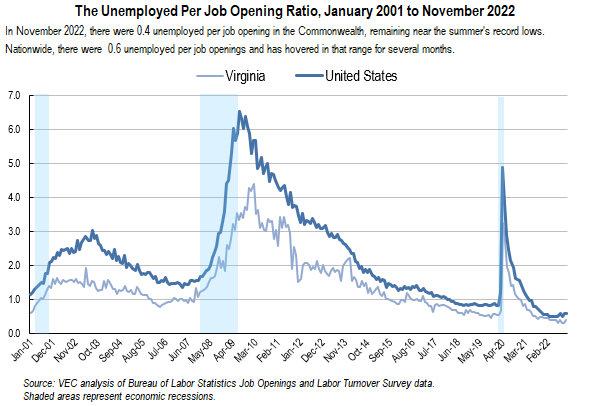
In November 2022, there was less than one unemployed worker per two job openings in the Commonwealth, as had been the case for most of 2022. This period marked the lowest rates since January 2001, when BLS began collecting the data. In Virginia, the unemployed per job opening ratio (sometimes called the ‘job seekers ratio’) peaked at 4.4 unemployed per job opening in February 2010 during the Great Recession, while the number of unemployed workers per job opening stood at 3.3 in April 2020 during the height of pandemic employment impacts. Across the U.S., there was a ratio of unemployed people to job openings of 0.6 for November, unchanged over the month. The ratio of unemployed people per job opening has been below 1.0 since July 2021. The number of unemployed people per job opening nationwide reached its highest level of 6.4 in October of 2009, at the height of the Great Recession.
The number of hires in Virginia rose by 4,000 to 168,000 in November, which was 2.4 percent higher over the month and up by over 6 percent year over year. JOLTS defines hires as all additions to the payroll during the month. The series low of 77,000 was set in April 2020, while the high of 265,000 was set in June of that year. In November, the number and rate of hires nationwide changed little at 6.1 million and 3.9 percent, respectively. Hires increased in health care and social assistance (+74,000). The number of hires increased in 3 states, decreased in 3 states, and was little changed in 44 states and the District of Columbia in November. The increases in the hires level occurred in Texas (+57,000). In Virginia, the hires rate edged up to 4.1 percent from October’s revised 4.0 percent rate. The national hires rate of 3.9% was little changed over the month. In November, hires rates increased in 4 states, decreased in 3 states, and were little changed in 43 states and the District of Columbia. The largest increases in hires rates occurred in Maine (+1.3 percentage points), Iowa (+0.9 point), and North Dakota (+0.7 point).
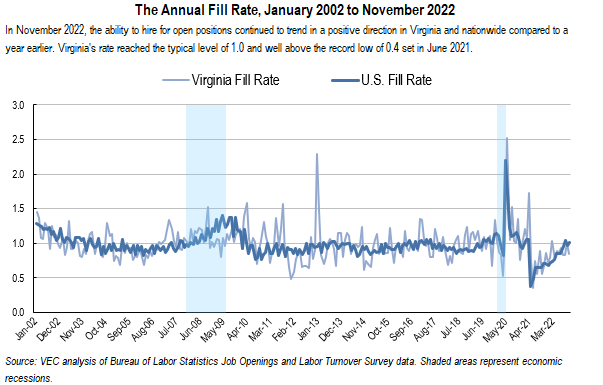
In November 2022, the ‘annual fill’ rate (the ratio of ‘this month’ hires to ’last month’ job openings, over the year) returned the level of .9 after bumping up to 1.0 in October. The U.S. annual fill rate edged slightly lower but was still near 1.0. This indicates a trend in recent months towards less difficulty in filling positions when compared to a year earlier. The fill rate is a measure used to evaluate how labor markets differ in the pace that job openings are filled. An annual fill rate near or above 1.0 can indicate that employers are growing more efficient at filling job openings. On the other hand, an annual fill rate of less than 1.0 can indicate a tighter labor market, with employers having greater difficulty filling job openings compared to a year earlier. Going back to 2001, the highest annual fill rate occurred during June 2020 because, after the nationwide shutdown due to the COVID-19 pandemic, employers across the country sought to quickly hire for vacated positions. The lowest fill rate in Virginia occurred in June 2021. During that time, there were many factors that hindered the filling of vacant positions by employers, such as health concerns, employee skills, and childcare needs, but the biggest factor was the comparison against
the historic re-hiring hike the year before.
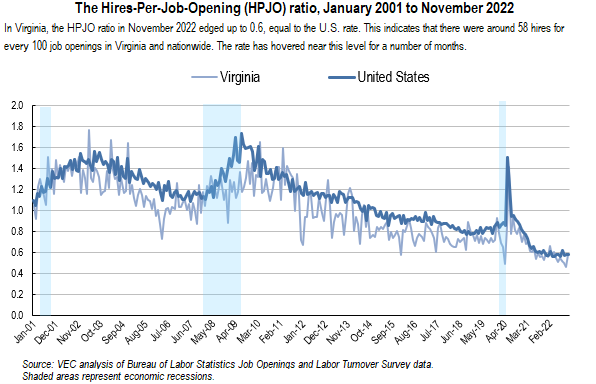
The hires-per-job-openings (HPJO) ratio edged upward to 0.6 in November, matching the rate nationwide. This measure shows the rate of hiring compared to open jobs and is a proxy for time to fill positions. In 2022, the rate has hovered around one hire for every two job openings in Virginia and in the Commonwealth.
In November, the number of total separations in Virginia decreased by 5,000 to 159,000 but rose 18 percent over the year and compared to five years earlier. Nationwide, the number of total separations changed little at 5.9 million. The number of total separations increased in health care and social assistance (+99,000) and in transportation, warehousing, and utilities (+76,000). The Virginia total separations rate was little changed, edging down to 3.9 percent from 4.0 percent in October. Over the month, the national total separations rate held at 3.8 percent. In November, total separations rates increased in six states, decreased in two states, and were little changed in 42 states and the District of Columbia. The largest increases in total separations rates occurred in Washington (+1.0 percentage point) and Iowa (+0.8 point), as well as in Colorado, Connecticut, and Oregon (+0.7 point each). In November, the total separations rate increased in establishments with 50 to 249 employees.
An estimated 109,000 workers quit jobs from Virginia employers in November. The number of quits fell by 13,000 from October’s revised figure of 122,000 but was up by 9 percent compared to November 2021. The number of quits was down significantly from the record-breaking month of December 2021, decreasing by 20 percent. Quits, a component of total separations, are voluntary separations initiated by the employee. They can be seen as a leading indicator of wage trends in that it includes workers who quit to move to another job. In November, the number of quits nationwide were little changed at 4.2 million. Quits increased in health care and social assistance (+82,000); transportation, warehousing, and utilities (+73,000); and information (+19,000). The number of quits increased in 5 states, decreased in 1 state, and was little changed in 44 states and the District of Columbia in November. The largest increases in the quits level occurred in California (+86,000), Washington (+26,000), and Indiana (+12,000). The decrease in the quits level occurred in North Carolina (-16,000). The quits rate in the Commonwealth decreased by 0.3 of a percentage point to 2.7 percent but remained at the elevated levels seen over the last twelve months. Over the month, the national quits rate was little changed at 2.7 percent. The largest increases in quits rates occurred in Washington (+0.7 percentage point), Iowa (+0.6 point), and California (+0.5 point). The quits rate increased in establishments with 1 to 9 employees.
The number of layoffs and discharges in Virginia increased by 4,000 to 41,000 in November 2022 from October’s revised 37,000 figure. While still low, this was nearly 46 percent growth over the year, and 28 percent higher than five years before in 2018. Layoffs and discharges are countercyclical, which means that layoffs typically increase during economic contractions and decrease during economic expansions. In November, the number of U.S. layoffs and discharges changed little at 1.4 million, and the rate remained at 0.9 percent. Layoffs and discharges increased in finance and insurance (+19,000). The number of layoffs and discharges decreased in 5 states, increased in 2 states, and was little changed in 43 states and the District of Columbia in November. The largest decreases in the layoffs and discharges levels occurred in New York (-26,000), Ohio (-24,000), and Tennessee (-14,000). The increases in the layoffs and discharges level occurred in New Mexico (+5,000) and Alaska (+2,000).
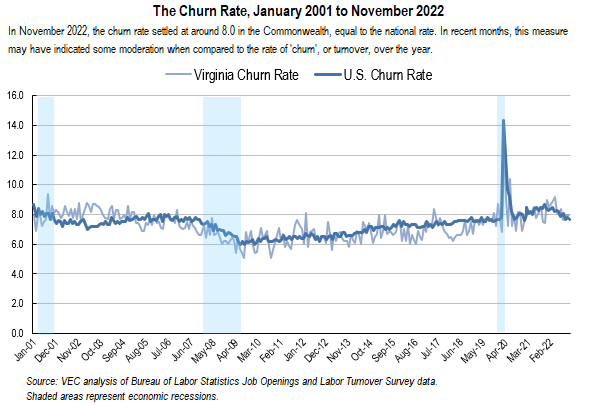
The November 2022 churn rate (the sum of the hires rate and the total separations rate) was unchanged from October’s revised 8.0 rate in Virginia, indicating continued elevated velocity of movement into and out of jobs but a little slower than earlier in the year. Nationwide performed similarly, as the U.S. churn rate was little changed over the month but signaled some deacceleration over the year. An elevated churn rate indicates a labor market with a high hires rate, a high separations rate, or both. It can signify that workers are moving more frequently into and out of jobs in the labor market. Conversely, a low churn rate indicates a labor market with a low hires rate, a low separations rate, or both. Labor markets with the most churn may also have more seasonal employment patterns not fully captured by seasonal adjustment factors, which can lead to more frequent job-to-job movement.
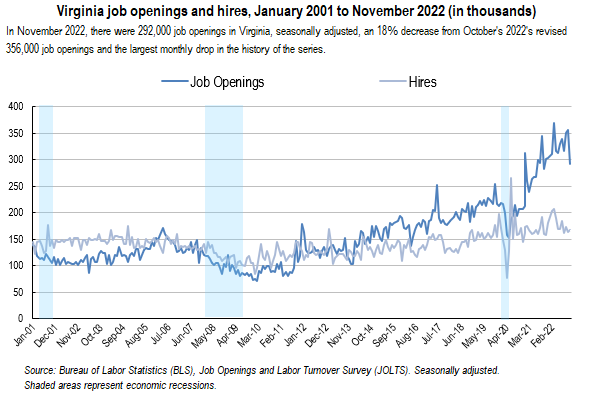
On the last business day of November 2022, the number and rate of job openings in Virginia decreased significantly but most other JOLTS indicators showed less change. Overall, these measures indicated continued tight labor market conditions as 2022 neared a close. But some important JOLTS measures had slowed significantly from their peaks. The number of job openings was down around twenty percent from its March 2022 peak while the number of quits was also down by twenty percent from its December 2021 peak. Many JOLTS records were set during the early months of the pandemic in 2020 and labor markets have moderated from the extremes experienced during that period to much more normal levels. For example, the number of November hires was 37 percent lower than June 2020’s peak and layoffs were a small percentage of March 2020’s peak.
###
The Virginia Employment Commission plans to release the December 2022 analysis of the BLS Job Openings and Labor Turnover Survey for Virginia on Friday, February 17, 2023. The data for all states and the U.S. will be available on the BLS website JOLTS page, at https://www.bls.gov/jlt/. BLS is scheduled to release the December JOLTS data for states on Wednesday, February 15, 2023.
Technical note: The Bureau of Labor Statistics (BLS) Job Openings and Labor Turnover Survey (JOLTS) produces monthly data on U.S. and regional job openings, hires, quits, layoffs and discharges, and other separations from a sample of approximately 21,000 establishments. As a supplement, BLS has begun publishing state estimates that provide monthly information that can be used to better understand the dynamic activity of businesses in state economies that leads to aggregate employment changes. For more information on the program’s concepts and methodology, see “Job Openings and Labor Turnover Survey: Handbook of Methods (Washington, DC: U.S. Bureau of Labor Statistics, July 13, 2020), https://www.bls.gov/opub/hom/jlt/home.htm. For more information on BLS’ state JOLTS estimates, see https://www.bls.gov/jlt/jlt_statedata.htm.
Definitions of JOLTS terms*
Job Openings
Job openings include all positions that are open on the last business day of the reference month. A job is open only if it meets the following three conditions: (1) A specific position exists and there is work available for that position; the position can be full time or part time, and it can be permanent, short term, or seasonal; (2) the job could start within 30 days, whether or not the employer can find a suitable candidate during that time; and (3) the employer is actively recruiting workers from outside the establishment to fill the position. Excluded are positions open only to internal transfers, promotions or demotions, or recalls from layoffs.
Hires
Hires include all additions to the payroll during the entire reference month, including newly hired and rehired employees; full-time and part-time employees; permanent, short-term, and seasonal employees; employees who were recalled to a job at the location following a layoff (formal suspension from pay status) lasting more than 7 days; on-call or intermittent employees who returned to work after having been formally separated; workers who were hired and separated during the month; and transfers from other locations. Excluded are transfers or promotions within the reporting location, employees returning from a strike, and employees of temporary help agencies, employee leasing companies, outside contractors, or consultants.
Separations
Separations include all separations from the payroll during the entire reference month and are reported by type of separation: quits, layoffs and discharges, and other separations. Quits include employees who left voluntarily, except for retirements or transfers to other locations. Layoffs and discharges include involuntary separations initiated by the employer, including layoffs with no intent to rehire; layoffs (formal suspensions from pay status) lasting or expected to last more than 7 days; discharges resulting from mergers, downsizing, or closings; firings or other discharges for cause; terminations of permanent or short-term employees; and terminations of seasonal employees (whether or not they are expected to return the next season). Other separations include retirements, transfers to other locations, separations due to employee disability, and deaths. Excluded are transfers within the same location, employees on strike, and employees of temporary help agencies, employee leasing companies, outside contractors, or consultants.

